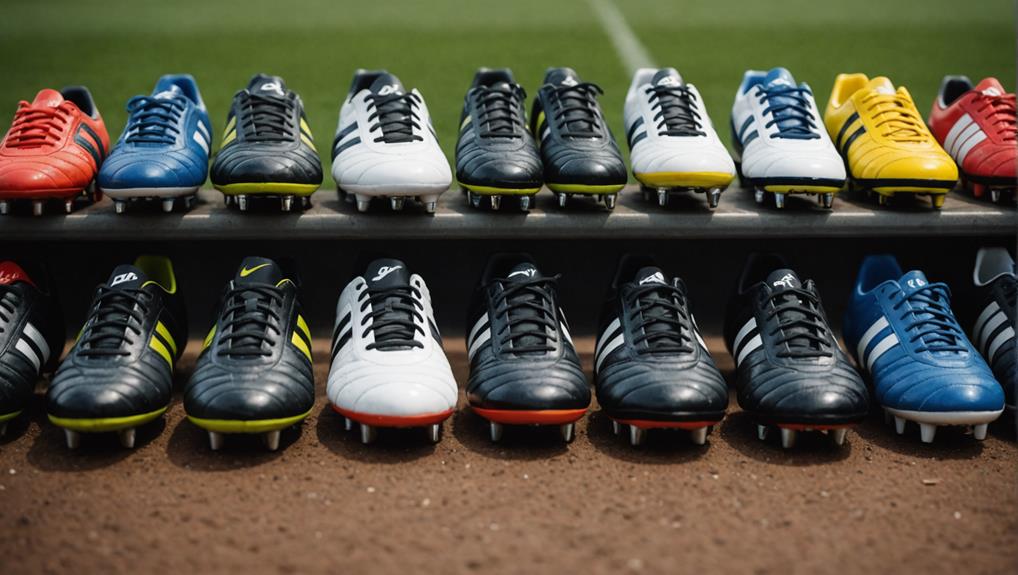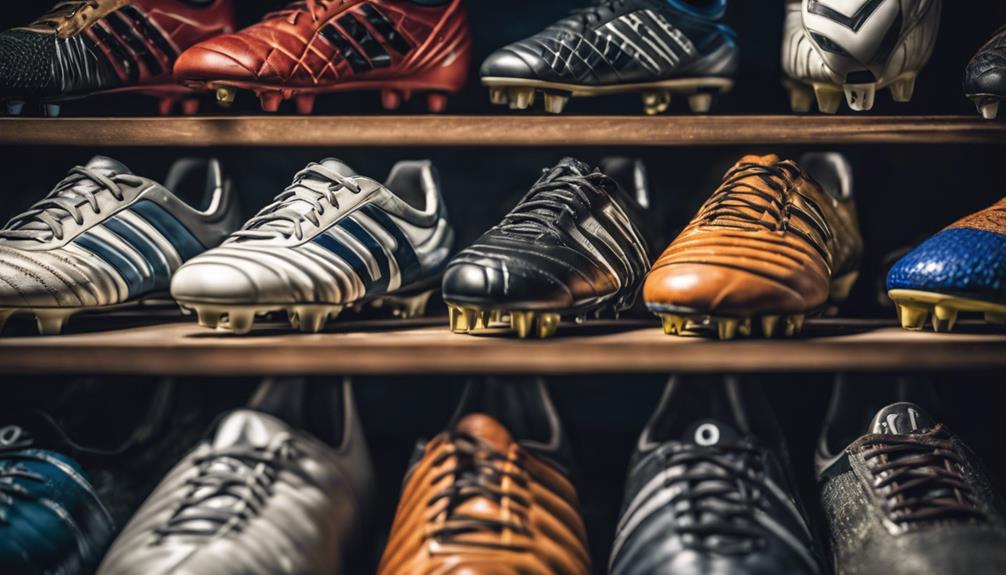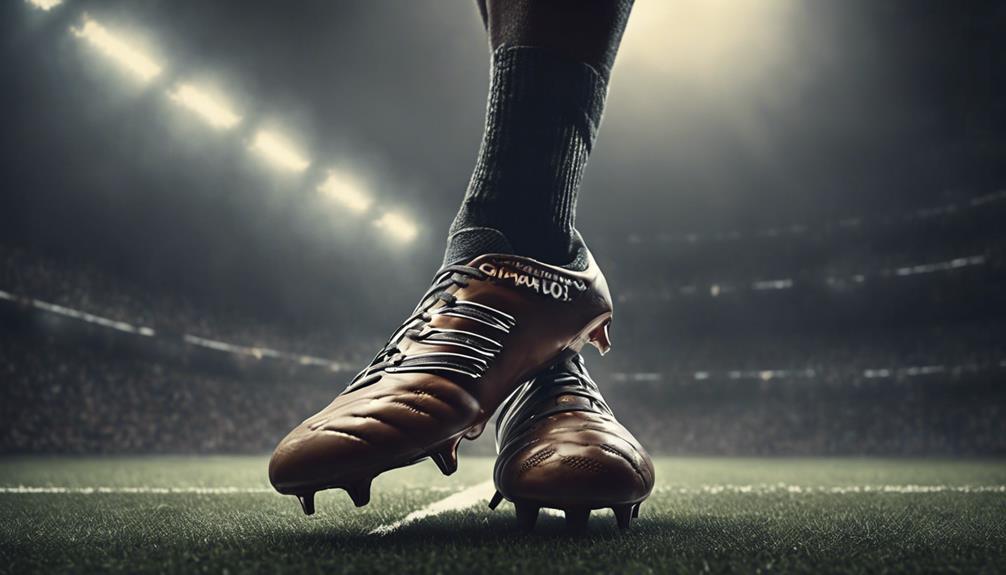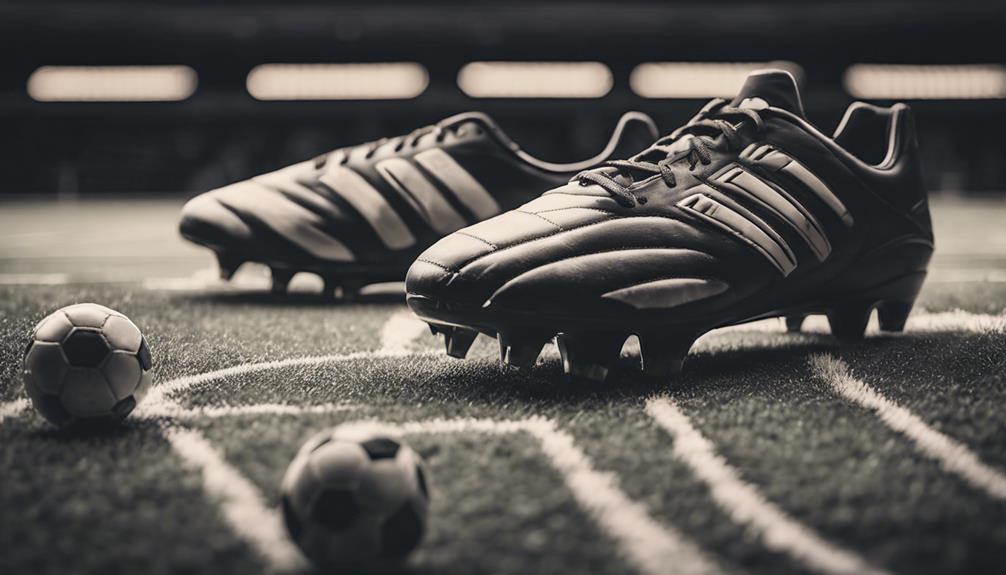
Comprehensive Soccer Cleat Size Chart
August 17, 2024When picking soccer cleats, focus on a snug fit to boost touch and control. Measure both feet and go with the longer measure for accuracy. For synthetic cleats, aim for a ¼ inch space between toes and cleat. Synthetic ones grant less flexibility compared to leather cleats. Consult sizing charts and brand-specific tips for the best match. Remember that different brands might have size variations due to material differences. A properly fitted cleat enhances agility and speed during gameplay, reducing discomfort and potential injuries.
Soccer Cleat Fit Tips
When selecting soccer cleats, prioritize a tight fit to enhance your touch and control on the field. The right size is important for best performance. Measure both feet and use the longer measurement to guarantee accuracy.
For synthetic cleats, opt for a tight fit to improve your touch and control. Make sure there's about a ¼ inch gap between the cleat and your toes for proper fit. Keep in mind that leather cleats tend to stretch with wear, while synthetic cleats offer less flexibility.
Consider consulting different sizing charts and brand-specific tips to find the best fit for your feet. A tight fit not only enhances your performance but also prevents injuries on the field.
Take into account the toe space and overall comfort when choosing the perfect pair of soccer cleats for your game.
Foot Measurement Guide
To guarantee the best fit for your soccer cleats, follow these steps:
- Stand on paper and trace your foot, measuring from the heel to the longest toe.
- Remember to measure both feet and use the larger measurement for sizing.
Foot Measurement Tips
For accurate sizing of soccer cleats, start by standing on paper and tracing your foot to measure from the heel to the longest toe. Remember to measure both feet as one foot is usually larger than the other, ensuring the right fit and avoiding discomfort.
Use the measurement of the larger foot for sizing to guarantee ideal comfort while playing. To obtain accurate measurements, it's recommended to measure your feet at the end of the day when they're slightly swollen and wear the soccer socks you intend to use during play. This practice will help you get a better idea of the space needed within the cleats for a snug but not tight fit.
Repeat the measuring process for both feet to confirm sizing consistency and make sure you have the most precise measurements for selecting the right soccer cleats for your feet.
Sizing for Cleats
Using the foot measurement guide, determine the correct size for your soccer cleats by measuring from the heel to the longest toe. For a snug fit, use the longer foot measurement when selecting your cleat size.
Keep in mind that different brands may have slight variations in sizing, so always refer to the specific brand's size chart to secure an accurate fit.
The material of the cleats, whether leather or synthetic, can impact the overall fit and stretch of the shoe. When trying on cleats, make sure there's a small gap of about ¼ inch between the cleat and your toes. This gap allows for prime comfort and performance on the field.
Cleats Material Impact

Leather cleats and synthetic options offer distinct advantages when it comes to fit and feel on the field. Understanding how each material influences sizing across different brands can help you find the perfect cleats for your game.
Whether you prefer the flexibility of leather or the immediate snugness of synthetic, knowing the impact of cleat materials is essential for your comfort and performance.
Cleat Material Influence
When choosing soccer cleats, consider the material's impact on fit and performance. Leather cleats offer a snug fit that can be customized over time for maximum comfort and performance. Kangaroo leather, known for its flexible nature, provides a soft and adaptable feel, enhancing comfort during play.
On the other hand, synthetic cleats, while offering less flexibility, require an initial snug fit to prevent slippage and achieve top performance on the field. It's crucial to select the cleat material that aligns with your preferences and playing style to get the most out of your soccer experience.
- Leather cleats naturally adapt with wear, providing a personalized fit over time.
- Kangaroo leather is highly flexible, providing a soft and adaptable feel for improved comfort.
- Synthetic cleats offer less flexibility, so it's essential to ensure a snug fit from the beginning.
Sizing Across Brands
Consider how different brands size their cleats to accommodate the material's impact on fit and performance.
When it comes to soccer cleats, the material used plays a significant role in how they fit on your feet. Leather cleats, known for their natural stretch over time, offer a customizable fit that molds to your foot shape. Kangaroo leather, in particular, is highly pliable, making it a preferred choice for players seeking comfort and flexibility.
On the other hand, synthetic cleats provide less stretch than leather options, emphasizing the importance of a snug fit from the start to prevent slippage during play. With synthetic cleats, it's vital to aim for a tight fit initially. While leather cleats can be stretched for adjustments, synthetic cleats require a precise fit from the beginning to ensure peak performance and comfort on the field.
Be mindful of these material-specific characteristics when selecting the right size across different brands to enhance your overall soccer experience.
Brand Sizing Variations
For the best match, always refer to brand-specific sizing charts when selecting soccer cleats. Each brand has its own distinctive approach to sizing, so understanding these variations can help you find the perfect match.
Here are some key points to keep in mind:
- Adidas offers wide fit options and a diverse selection of soccer cleats specifically designed for women.
- Nike has shifted towards unisex sizing for their soccer cleats, so make sure to check the sizing charts for accurate measurements.
Remember to consult brand-specific sizing information for fit recommendations tailored to each brand's unique sizing standards.
Wrong Size Solutions

If you find yourself with the wrong size soccer cleats, there are solutions available to guarantee a perfect fit. Take advantage of free returns and exchanges offered by many retailers to swap your cleats for the correct size.
Additionally, some brands provide a 30-Day Wear Test Guarantee, allowing you to exchange the cleats hassle-free if they don't fit well during practice or games. Customer satisfaction is a top priority for most companies, so they aim to make the return and exchange process as easy as possible.
When exchanging for a different size or style, make sure you consult the most recent sizing information to make accurate choices. By utilizing these wrong size solutions, you can ultimately achieve the perfect fit for your soccer cleats, enhancing your comfort and performance on the field.
Mens Footwear Conversion
To accurately convert men's footwear sizes, refer to the corresponding US, Euro, and UK measurements provided in the sizing chart.
When converting sizes, keep in mind the measurements for Soccer Cleat sizes from US 5.5 to 46.5, Euro 23.7 to 27.1, and UK 6.5 to 10.5.
Confirm the precision of your conversions by noting that Euro sizes translate to 23.5 to 24.8 centimeters, and UK sizes to 9.3 to 24.1 inches.
To guarantee the right fit, consider the men's to women's U.S. size conversions, ranging from 3.5 to 7.5 for men and 5.5 to 9.5 for women.
Remember that different brands may have unique sizing considerations, so consult brand-specific charts for precise measurements.
Glove & Sock Sizes

Soccer players can optimize their performance and comfort by selecting the appropriate sizes for gloves and socks. When it comes to glove sizes, options typically range from 5 to 12, with measurements provided in inches and centimeters for a precise fit. Brands like Nike, Adidas, and Puma offer specific sizing charts for socks to guarantee they provide both comfort and support during gameplay.
Understanding sock sizes is essential to prevent blisters and discomfort while on the field. For goalkeeper gloves, sizes are available for kids, youth, and adults, with variations in palm size and wrist closure. Securing a proper fit for gloves and socks can't only enhance your performance but also protect you from common soccer-related injuries.
Soccer Club Size Charts
Discover specific measurements tailored to popular soccer clubs like Arsenal F.C., FC Barcelona, and Manchester United F.C. through their dedicated size charts. When exploring Soccer Club Size Charts, remember that these measurements cater to various body types and preferences, ensuring the perfect fit for fans' favorite team apparel and merchandise.
Here's what you need to know:
- Soccer club size charts provide precise measurements for jerseys, jackets, and team gear.
Each club's size chart may vary, so it's crucial to refer to the specific measurements provided.
The size charts cater to different body types and preferences, ensuring fans can find the perfect fit.
Conclusion
Now that you have all the information you need to find the perfect soccer cleat size, you can step onto the field with confidence and comfort.
Remember, the right fit can make all the difference in your performance, so take the time to measure your feet and try on multiple sizes to make sure you get the best fit possible.
Don't let the wrong size hold you back from reaching your full potential on the pitch.


